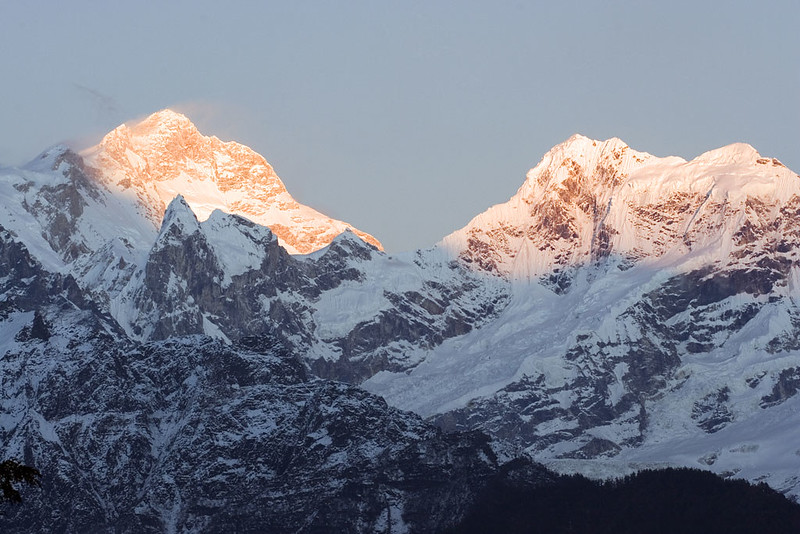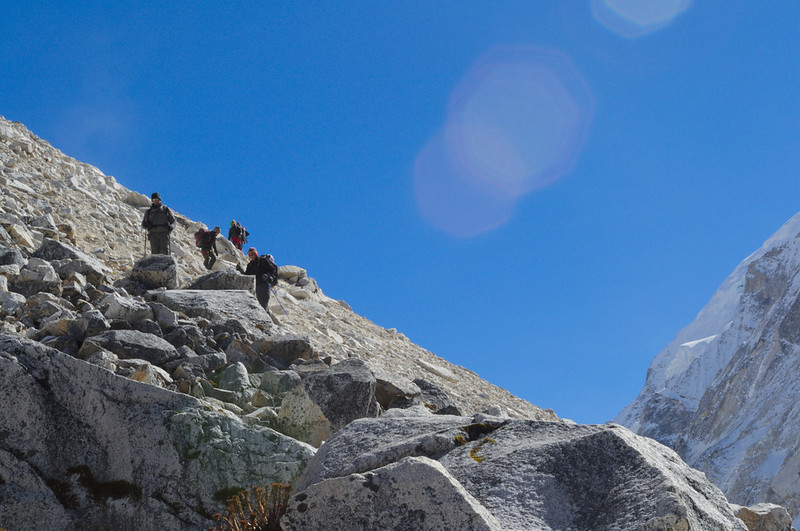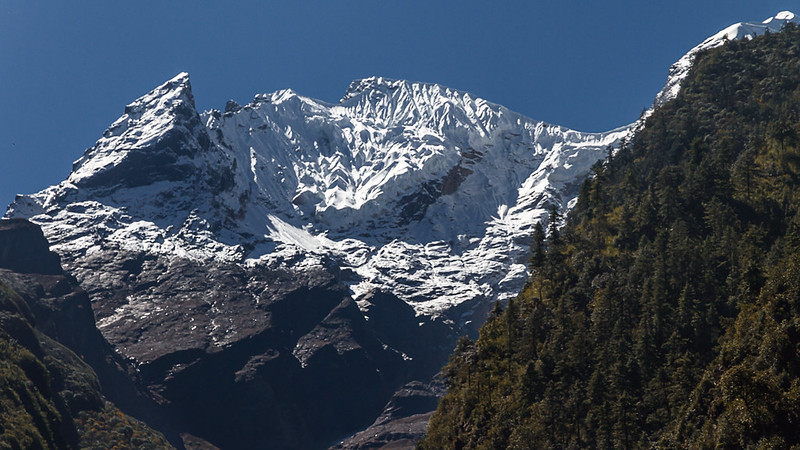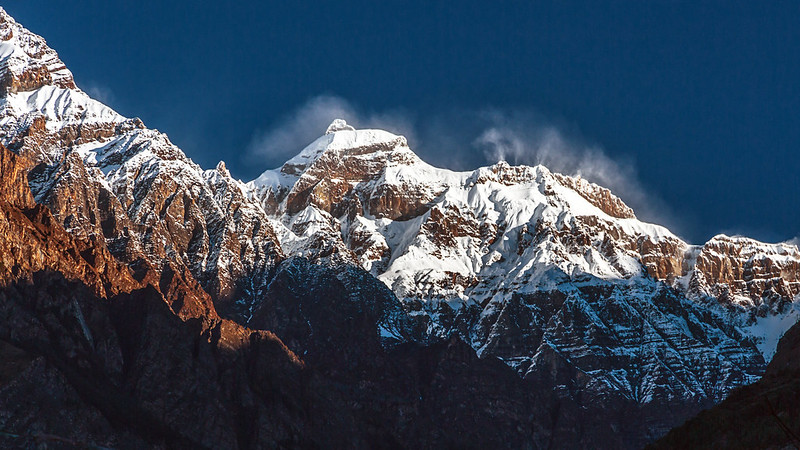Manaslu Circuit Trek is one of Nepal’s fairly difficult treks, taking you through isolated Himalayan communities. It is one of Nepal’s off-the-beaten-path treks. Manaslu Circuit Trek circles Mt. Manaslu, the world’s 8th highest peak at 8,163 meters (26,781 ft). And it’s quickly becoming known as the newest jewel in the Himalayan trekking community.
The Manaslu Circuit trek also makes for an excellent tea house trek. Some even call it Nepal’s greatest all-around or a circuit trek. Manaslu Circuit Trek is without a doubt a better alternative than the Annapurna Circuit Trek.

Photo credit: ૐ Didi ૐ on Visualhunt.com
Factors that determine the difficulty of the Manaslu Circuit Trek
Manaslu Circuit trek difficulty is determined by many factors like below:
Distance or Duration of the trek:
The Manaslu Circuit Trek is located in the Gorkha district, in the northern Himalayan range. The landscape varies greatly during this walk, with the lowest point being 228 meters and the highest point being 8,163 meters on Mt. Manaslu, the world’s eighth-highest peak.
The overall distance of the Manaslu Circuit Trek is around 177 kilometers. On a typical 17-day hike, you’ll be trekking for 10-12 days, covering an average distance of 15-20 kilometers each day. The trek gets challenging after the first five days because the Budhi Gandaki Gorge is quite steep. You’ll also have to trek up and down a lot of hills.
You’ll have to stroll over winding pathways and pass suspension bridges above the Budhi Gandaki River at points. However, there aren’t any suspension bridges throughout the path. To traverse the exhilarating rivers, you may have to cross wooden bridges made out of logs.
The most difficult day of the walk is crossing the Larkya La Pass at an elevation of 5,213 meters. On the other hand, it’s more of a measure of your endurance.
You must be physically and psychologically prepared for the rough terrain and rocky routes, which can be exhausting for those who are not in good physical shape. This does not imply that the walk is simple; to finish the trek successfully, you must be physically strong and in good shape.

Photo credit: Rojan Sinha on VisualHunt.com
Age and Physical Fitness:
The difficulty of a trek is determined by the trekker’s age and physical condition. As a person gets older, his activity level and bodily flexibility vary as well! With age, a person’s self-confidence grows, bodily strength develops, and the body’s flexibility, strength, and attentiveness steadily decline after the age of 50.
As a result, the trekker’s age has a direct impact on how simple or tough the trek is. At the same time, your physical fitness is an important consideration for high-altitude trekking. It is critical to know how to stay active in high alpine places with average stamina even when oxygen levels are low.
As a result, the age and physical fitness of the trekker also impacted how simple or difficult the same trekking trail was for various people.
Despite the distant location, you are not expected to be in excellent physical condition. With a reasonable degree of fitness and no physical issues, you may participate in this expedition. To accomplish this journey, you must also be able to tolerate long hours of walking in a steep and mountainous environment for a few days.
Weather:
The weather may make a major impact on the difficulty of your Manaslu Circuit Trek. Throughout your trekking trip, you may encounter heavy rain, frigid nights, scorching sun, and a chilly breeze.
The days are usually pleasant and dry, while the nights are usually mild. Make sure to bring warm clothing for the evening and night, as well as a good sleeping bag. Layering is crucial when it comes to clothes.
Trekking in the Manalsu area during the winter may be difficult. The Larkya La Pass is blocked throughout the winter owing to excessive snowfall.
In addition, the tea house along the paths is closed. As a result, you must arrange lodgings ahead of time and confirm that they are available. The temperatures are also below zero at night. The temperature remains constant during the day, and you get a clear view of the mountains.
Summer follows the rainy season, thus there is a lot of rain during this time. The route is slick, muddy, and full of leeches as a result of the recent rain. The Larkya La Pass is also demanding since the path is rough and dangerous.
In terms of clear weather, the spring season is one of the ideal times for trekking. You’ll also get the best views of the snow-capped peaks. It’s also the best time to see the rhododendrons blossom. In addition, woodlands are transformed into lovely multicolored gardens.
The fall season is the best time for Manaslu Circuit Trek because of the pleasant weather. The weather is good, with a consistent temperature, and the magnificent mountain views are breathtaking!
Altitude Sickness:
At any elevation above 2,000 meters, Acute Mountain Sickness (AMS) might occur. The Manaslu Circuit Trek begins at a lower elevation and climbs to the Larkya La pass. As a result, as the altitude rises, the threat of altitude sickness rises as well.
A headache, intense weariness, and a loss of appetite are the first signs. At repose, some people develop shortness of breath.
The accumulation of fluid in various regions of the body causes AMS. It’s not supposed to be there: in the brain, the lungs, or both. When minor symptoms appear, it’s a hint that you should stay at that altitude until they go.
Never ascend if you have any AMS symptoms! You should feel better in one or two days and be able to resume your walk.
If your symptoms are getting worse while you’re resting at the same altitude, it’s time to descend. AMS symptoms that worsen include fatigue, severe headaches, vomiting, and lack of coordination.
HACE (High Altitude Cerebral Edema) symptoms are present. If escalating symptoms are neglected, HACE can result in unconsciousness and death within 12 hours.
High Altitude Pulmonary Edema, or HAPE, is characterized by breathing difficulties, cough, and fatigue. If left untreated, HAPE can be deadly.
Compulsory requirement of trekking guide
If you’re considering doing the Manaslu Circuit Trek without the need for a guide, you should reconsider. The Nepalese government has made it compulsory for all international trekkers to obtain a permit. In the restricted region, you must be guided by a licensed guide.
Because the Manaslu region is now one of the government’s prohibited regions, trekking without a guide is impossible. Manaslu Circuit Trek, Tsum Valley, Larkya La Pass, and Manaslu Base Camp are among the other trekking routes that share boundaries with Tibet.
No Luxurious Accommodation:
In the Manaslu Circuit Trek, lodging is not a difficulty. The paths are normally deserted or little populated, and newly improved tea houses are constantly opening. However, these tea houses may not be as luxurious as those found in high-end hotels and restaurants.
Every day of the walk is exhausting, and you’ll want to take a hot shower and feel refreshed all of the time. Showers or baths are not available at higher elevations owing to the cold and the cost.
While some lodges may offer excellent restrooms, others may merely give you pails of water to bathe in. These will set you back a few bucks each time, but they will not provide the same level of relaxation as a genuine bath. Instead, carrying wet wipes and a tiny towel to freshen yourself in the morning and before bed is a wonderful idea.
As you spend days in the mountains, you will need to charge your electronic devices such as cameras, phones, iPods, and other such devices. The cost is normally a few dollars, but charging multiple things every day will cost you more in the long term.
Supporting local hydropower stations comes at a higher price. If you wish to avoid paying this fee, consider carrying a solar-powered rechargeable battery or a portable energy bank.
Permits Required for Manaslu Circuit Trek
Manaslu Restricted Area Permit (Manaslu RAP)
The limited stretch of the Manaslu Circuit Trek is from Jagat to Sama Gaun. For this stretch, you’ll need to obtain a permit. You’ll need the ACAP after displaying the Manaslu Restricted Area Permit at the Sama Gaun checkpoint.
The cost of a restricted area permit is also determined by the trek’s duration. The days spent traveling between Jagat and Sama Gaun are also important considerations when determining the cost of a permit. The Manaslu RAP may be obtained by filling out an online application. The following is the cost of a permit for each season:
September to November: For the first seven days, the Manaslu Restricted Area permit costs USD 100 per person. You will require an extra USD 15 per person every day from then on.
The Manaslu Restricted Area permit costs USD 75 per person for the first 7 days from December to August. You will require an extra USD 10 per person every day from then on.
Annapurna Conservation Area Project (ACAP Permit)
Before passing through the conservation area at Dharapani, you must have an Annapurna Conservation Area Permit (ACAP). Although trekkers will only be in the Annapurna protection region for a few days, they must obtain this permission.
The ACAP permit is the same price as the MCAP permit and is valid all year. The price of this permit does not alter depending on the season. This permission must be obtained in person with a printed picture.
The ACAP Entry Fee for SAARC citizens is NRs. 1000 per person. The ACAP Entry Fee for other nationalities is NRs.3000 per person. This permission costs roughly NRs.100 for Nepalese and is free for children under the age of ten.
Manaslu Conservation Area Project (MCAP Permit)
In Nepal, all conservation sites require specific authorization. The Manaslu Conservation Area begins at Philim, and an MCAP Permit is required to hike there. The cost of an MCA permit remains consistent throughout the year. It makes no difference how long you stay on the walk because there are no limits or pricing adjustments.
The MCA Permit costs NRs.1000 per person for SAARC nationals. The MCA Permit costs NRs.3000 per person for other nations. This permit costs Rs.100 and is only available to Nepalese citizens. Furthermore, it is free for children under the age of ten.
Other permits:
You’ll also need a Tsum Valley Permit if you wish to extend your journey to Tsum Valley in Manaslu Circuit Trek. From September through November, this permit will cost USD 40 per person for a week. It costs USD 7 per person each day after that.
Furthermore, from December to August, this permit will cost USD 30 per person for a week. It costs USD 7 per person each day after that. If you want to continue your journey to Muktinath, Jomsom, or Pokhara, you’ll need a TIMS card because you’ll be trekking the Annapurna Circuit Trek or the Annapurna Base Camp route.
The Trekker’s Information Management System (TIMS) Card is NRs. 1,000. The TIMS Card for SAARC nations is NRs. 300. These TIMS cards are critical for locating and rescuing trekkers in an emergency.

Photo credit: korzh roman on VisualHunt
Required Documents for Manaslu Circuit Trek Permit:
After providing the relevant documentation, the Manaslu Circuit Trek is granted by the concerned authorities. Permits can also be obtained at checkpoints under certain circumstances. These Manaslu Circuit Trek permits, however, are not free. The Nepal government requires the following documents to apply for a permit on Mt. Manaslu:
- Authentic passport
- A total of four passport-sized pictures are required.
- Arrival stamp on a Nepali visa.
- Cash to pay the fee and charges for permits
- Papers about travel insurance can be read.
- A copy of the air tickets with the arrival and departure dates.
- A scanned copy of your passport, as well as your Nepal visa.
- Consent letter to the Director of Immigration. You must state the purpose of the permit ahead of time.
- The trekking company’s consent letter. You must ensure that you will have all of the relevant documentation when you arrive.
